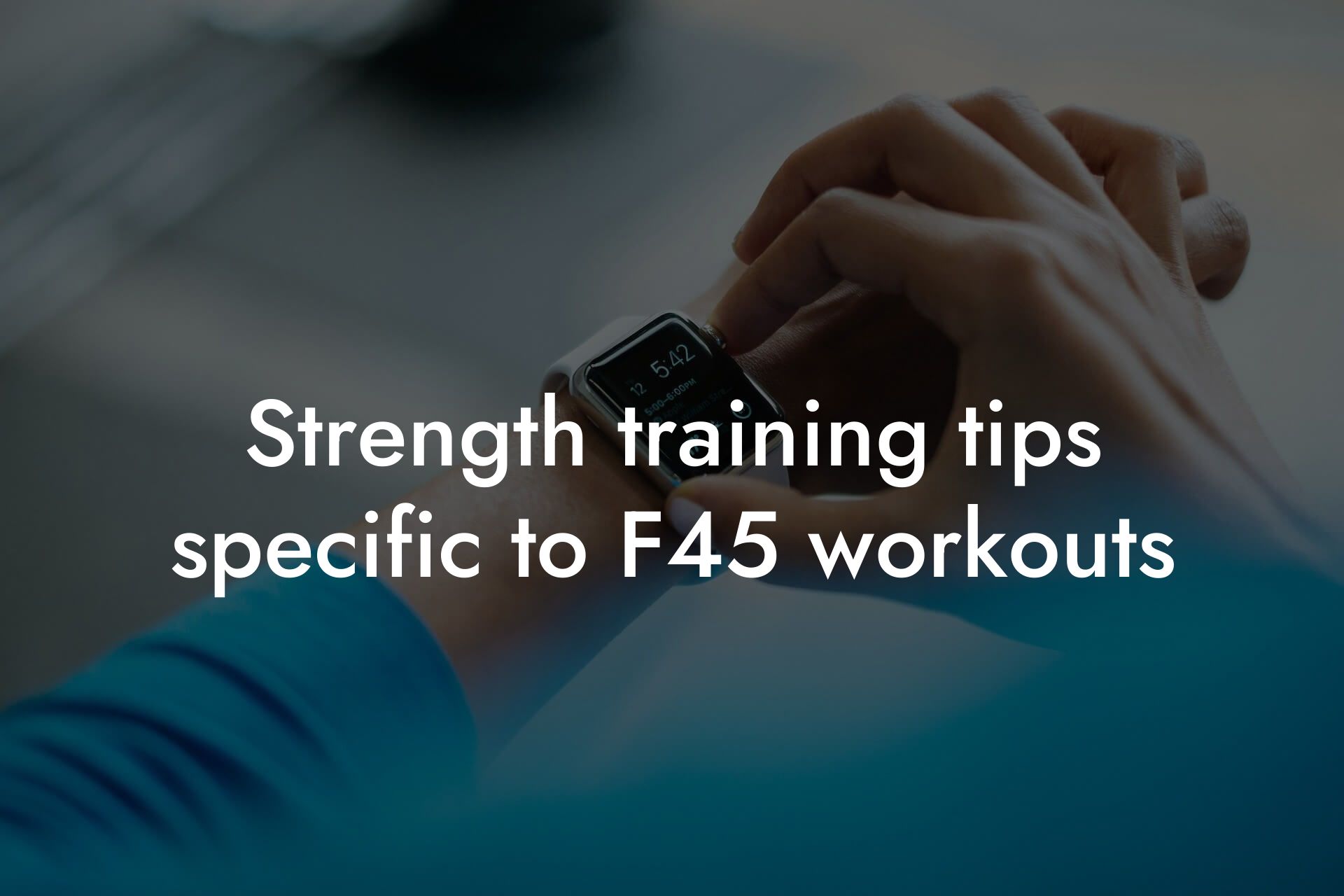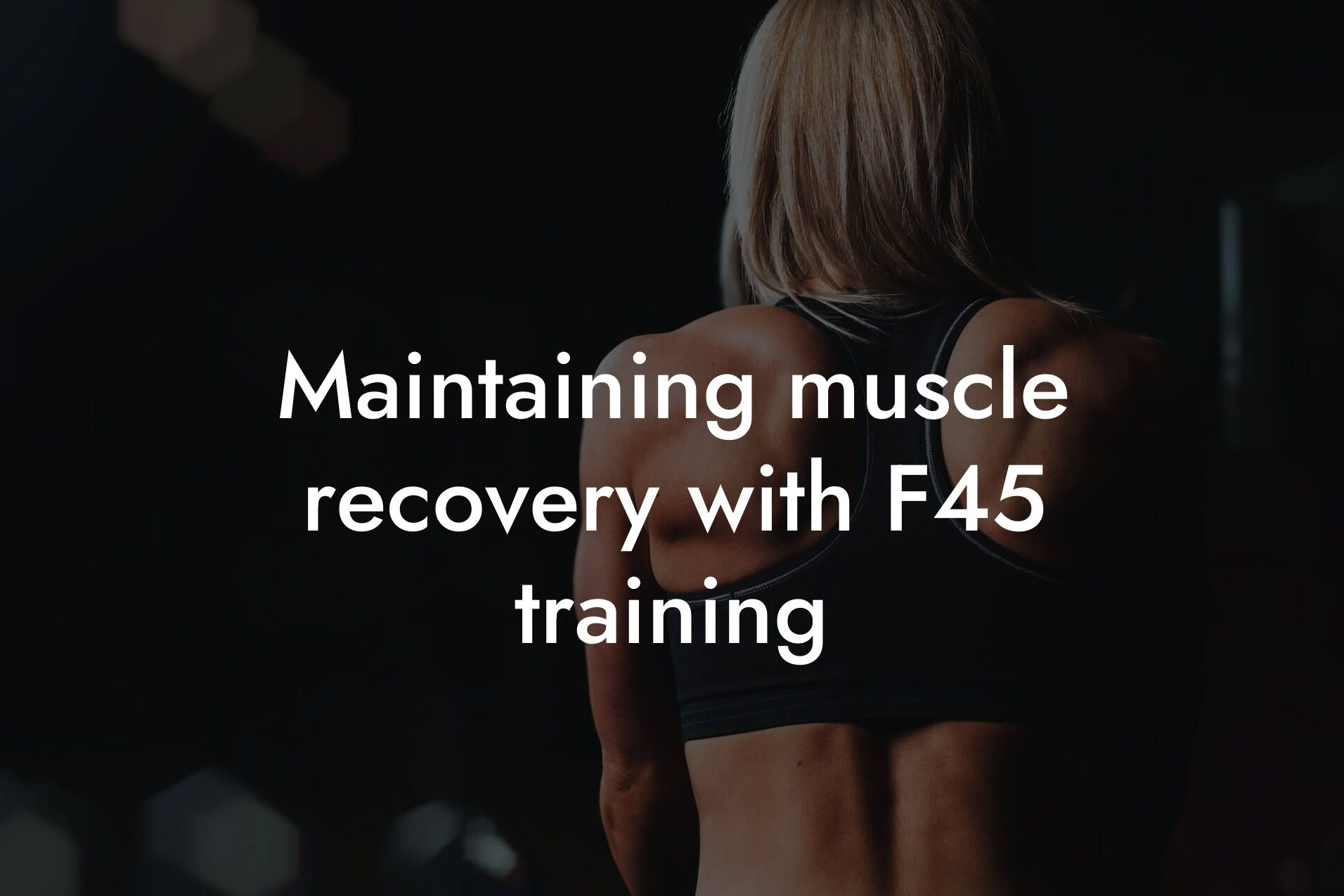As a high-earning professional, you understand the importance of maintaining a healthy and fit physique. F45, a popular high-intensity interval training (HIIT) program, can be an excellent way to achieve your fitness goals. However, it's crucial to balance strength and flexibility in your F45 workouts to avoid injuries, improve performance, and enhance overall well-being. In this article, we'll delve into the importance of balancing strength and flexibility in F45, and provide you with practical tips and strategies to achieve optimal results.
Table of Contents
- Why Balance is Crucial in F45
- The Consequences of Ignoring Flexibility in F45
- Benefits of Balancing Strength and Flexibility in F45
- Practical Tips for Balancing Strength and Flexibility in F45
- Incorporating Flexibility Exercises into Your F45 Routine
- Using DEXA Scans to Monitor Progress and Identify Imbalances
- Frequently Asked Questions
Why Balance is Crucial in F45
In F45, you're likely to engage in a variety of exercises that target different muscle groups, such as squats, lunges, push-ups, and burpees. While building strength is essential, it's equally important to maintain flexibility to prevent injuries and improve range of motion. When you focus solely on building strength, you may develop muscle imbalances, where some muscles become overdeveloped and others remain weak. This can lead to poor posture, decreased athletic performance, and increased risk of injury.
The Consequences of Ignoring Flexibility in F45
Ignoring flexibility in F45 can have serious consequences, including:
- Decreased range of motion, making it difficult to perform daily activities and exercises
- Increased risk of injury, as tight muscles are more prone to strains and pulls
- Poor posture, which can lead to back, neck, and shoulder pain
- Decreased athletic performance, as inflexible muscles can't generate maximum power and speed
- Increased muscle soreness and fatigue, making it challenging to recover from intense workouts
Benefits of Balancing Strength and Flexibility in F45
On the other hand, balancing strength and flexibility in F45 can bring numerous benefits, including:
- Improved range of motion, allowing for more efficient and effective exercises
- Reduced risk of injury, as flexible muscles are more resilient to stress and strain
- Enhanced athletic performance, as flexible muscles can generate more power and speed
- Better posture, reducing the risk of back, neck, and shoulder pain
- Faster recovery, as flexible muscles are less prone to soreness and fatigue
Practical Tips for Balancing Strength and Flexibility in F45
To balance strength and flexibility in F45, follow these practical tips:
- Incorporate stretching exercises into your warm-up and cool-down routines, focusing on major muscle groups like hamstrings, quadriceps, and hip flexors
- Make time for flexibility exercises, such as yoga or Pilates, 2-3 times a week
- Incorporate exercises that target multiple muscle groups simultaneously, like squats and lunges, to improve functional strength and flexibility
- Focus on controlled, slow movements during exercises, rather than rapid, jerky movements
- Listen to your body and take regular breaks to stretch and recover
Incorporating Flexibility Exercises into Your F45 Routine
To incorporate flexibility exercises into your F45 routine, try the following:
- Start with dynamic stretching exercises, like leg swings and arm circles, during your warm-up
- Incorporate static stretches, like hamstring and quadriceps stretches, during your cool-down
- Add flexibility exercises, like yoga or Pilates, to your routine 2-3 times a week
- Focus on exercises that target multiple muscle groups simultaneously, like squats and lunges
Using DEXA Scans to Monitor Progress and Identify Imbalances
As a high-earning professional, you understand the importance of tracking progress and identifying areas for improvement. At Tano Performance Group, we use DEXA scans to provide a comprehensive body assessment, including body fat percentage, muscle mass, and bone density. By regularly tracking your progress with DEXA scans, you can:
- Identify muscle imbalances and adjust your training program accordingly
- Monitor changes in body composition and adjust your nutrition and training program
- Track progress towards your fitness goals and make data-driven decisions
Balancing strength and flexibility in F45 is crucial for optimal performance, injury prevention, and overall well-being. By incorporating flexibility exercises into your routine, listening to your body, and tracking progress with DEXA scans, you can achieve a strong, flexible, and healthy physique. Remember, as a high-earning professional, taking care of your physical health is essential for maintaining peak performance in all areas of your life.
Frequently Asked Questions
What is F45 and how does it relate to balancing strength and flexibility?
F45 is a high-intensity interval training (HIIT) workout that combines elements of cardio, strength training, and functional movement. Balancing strength and flexibility is crucial in F45 as it helps improve overall fitness, reduces the risk of injury, and enhances performance. By incorporating exercises that target both strength and flexibility, F45 participants can achieve a more well-rounded fitness level.
Why is flexibility important in F45?
Flexibility is essential in F45 as it allows for a full range of motion, reduces muscle tension, and improves overall athletic performance. Increased flexibility also reduces the risk of injury, improves posture, and enhances overall mobility.
How does strength training benefit F45 participants?
Strength training is a critical component of F45 as it helps build muscle mass, increases bone density, and enhances overall athletic performance. By incorporating strength exercises into their F45 routine, participants can improve their power, speed, and agility, leading to better overall fitness.
What are some common flexibility exercises used in F45?
F45 incorporates a variety of flexibility exercises, including dynamic stretching, mobility exercises, and yoga-inspired movements. Some common flexibility exercises used in F45 include leg swings, arm circles, hip openers, and calf raises.
How can I improve my flexibility in F45?
To improve flexibility in F45, focus on incorporating dynamic stretching exercises into your warm-up and cool-down routines. Hold each stretch for 20-30 seconds and aim to stretch major muscle groups, including hamstrings, quadriceps, chest, back, and shoulders. Additionally, incorporate mobility exercises, such as leg swings and arm circles, into your routine.
What are some common strength training exercises used in F45?
F45 incorporates a variety of strength training exercises, including weightlifting, bodyweight exercises, and resistance band exercises. Some common strength training exercises used in F45 include squats, lunges, deadlifts, bench press, and rows.
How can I improve my strength in F45?
To improve strength in F45, focus on incorporating progressive overload into your workout routine. Gradually increase the weight, resistance, or reps over time to challenge your muscles and promote strength gains. Additionally, focus on proper form and technique to ensure you're targeting the correct muscle groups.
How often should I incorporate strength and flexibility exercises into my F45 routine?
Aim to incorporate strength and flexibility exercises into your F45 routine 2-3 times per week. This will allow for adequate recovery time and ensure you're making progressive gains in both strength and flexibility.
Can I still do F45 if I'm not flexible?
Absolutely! F45 is designed to be modified to suit individual fitness levels and abilities. If you're not flexible, start with modified exercises and gradually increase the intensity and range of motion as you become more comfortable. Focus on proper form and technique, and don't be afraid to ask for modifications or assistance from your instructor.
Will F45 help me lose weight?
F45 is a high-intensity workout that can help with weight loss, but it's also important to maintain a balanced diet and healthy lifestyle. By combining F45 with a healthy diet and regular cardio exercise, you can achieve significant weight loss and improve overall body composition.
How does F45 differ from traditional gym workouts?
F45 is a high-intensity interval training (HIIT) workout that combines elements of cardio, strength training, and functional movement. Unlike traditional gym workouts, F45 is a fast-paced, dynamic workout that changes daily, keeping your body guessing and preventing plateaus.
What is the importance of proper form and technique in F45?
Proper form and technique are crucial in F45 as they help prevent injury, ensure you're targeting the correct muscle groups, and promote optimal performance. Focus on maintaining proper form and technique throughout each exercise, and don't be afraid to ask for feedback or modifications from your instructor.
Can I do F45 if I have a pre-existing injury?
If you have a pre-existing injury, it's essential to consult with a doctor or healthcare professional before starting F45. Many F45 exercises can be modified to accommodate injuries, but it's crucial to prioritize your safety and well-being. Work with your instructor to develop a modified routine that suits your needs and abilities.
How can I track my progress in F45?
Track your progress in F45 by monitoring your workout performance, taking progress photos, and tracking your body fat percentage or weight. Additionally, work with your instructor to set and achieve specific fitness goals, such as increasing your squat depth or improving your overall endurance.
What are some common mistakes to avoid in F45?
Common mistakes to avoid in F45 include poor form and technique, inadequate warm-up and cool-down, and pushing yourself too hard. Remember to listen to your body, prioritize proper form and technique, and take regular breaks to avoid injury and burnout.
How can I stay motivated in F45?
Stay motivated in F45 by setting and achieving specific fitness goals, tracking your progress, and finding a workout buddy or accountability partner. Additionally, focus on the benefits of F45, such as improved energy levels, increased strength and flexibility, and enhanced overall fitness.
What are some benefits of incorporating F45 into my fitness routine?
Benefits of incorporating F45 into your fitness routine include improved cardiovascular health, increased strength and flexibility, enhanced athletic performance, and improved overall body composition. F45 also promotes mental toughness, discipline, and accountability, leading to a more well-rounded fitness level.
Can I do F45 at home?
While F45 is typically done in a studio setting, you can modify exercises to do at home. Focus on incorporating bodyweight exercises, resistance band exercises, and high-intensity interval training (HIIT) into your home workout routine. However, keep in mind that the social accountability and motivation of a studio setting can be beneficial for many individuals.
How does F45 compare to other HIIT workouts?
F45 is a unique HIIT workout that combines elements of cardio, strength training, and functional movement. While other HIIT workouts may focus solely on cardio or strength training, F45 provides a more well-rounded fitness experience. Additionally, F45's dynamic and constantly changing workout routine helps prevent plateaus and keeps participants engaged and motivated.
What are some tips for getting the most out of my F45 workout?
Tips for getting the most out of your F45 workout include arriving early to warm up, staying hydrated throughout the workout, and focusing on proper form and technique. Additionally, push yourself to new heights, take regular breaks to avoid burnout, and celebrate your progress and achievements.
How does F45 support overall health and wellness?
F45 supports overall health and wellness by providing a comprehensive fitness experience that targets cardiovascular health, strength, flexibility, and overall athleticism. Additionally, F45 promotes mental toughness, discipline, and accountability, leading to a more well-rounded and healthy individual.
Can I do F45 if I'm a beginner?
Absolutely! F45 is designed to be modified to suit individual fitness levels and abilities. As a beginner, start with modified exercises and gradually increase the intensity and range of motion as you become more comfortable. Focus on proper form and technique, and don't be afraid to ask for feedback or modifications from your instructor.
How does F45 differ from traditional cardio workouts?
F45 differs from traditional cardio workouts in that it incorporates strength training and functional movement exercises, providing a more comprehensive fitness experience. Additionally, F45's high-intensity interval training (HIIT) format helps prevent plateaus and promotes optimal calorie burn and fat loss.
Here are some related articles you might love...
- Strength training tips specific to F45 workouts
- Maintaining muscle recovery with F45 training
- The importance of bone density in F45 fitness
- Nutrition strategies for F45 athletes
- Reducing body fat for better F45 workout results
- How DEXA scans can benefit F45 training enthusiasts
- Preventing injuries during F45 training
- The role of body composition in F45 training performance
- Improving endurance for F45 training sessions
Zak Faulkner
Zak Faulkner is a leading authority in the realm of physical health and body composition analysis, with over 15 years of experience helping professionals optimise their fitness and well-being. As one the experts behind Tano Performance Group, Zak has dedicated his career to providing in-depth, science-backed insights that empower clients to elevate their physical performance and overall health.
With extensive knowledge of DEXA technology, Zak specializes in delivering comprehensive body assessments that offer precise data on body fat, muscle mass, bone density, and overall physique. His expertise enables individuals to make informed decisions and achieve their fitness goals with accuracy and confidence. Zak’s approach is rooted in a deep understanding of human physiology, combined with a passion for helping clients unlock their full potential through personalised strategies.
Over the years, Zak has earned a reputation for his commitment to excellence, precision, and client-focused service. His guidance is trusted by top professionals who demand the best when it comes to their health. Whether advising on fitness programs, nutritional strategies, or long-term wellness plans, Zak Faulkner’s insights are a valuable resource for anyone serious about taking their health and fitness to the next level.
At Tano Performance Group, Zak continues to lead our Content Team revolutionising how professionals approach their physical health, offering unparalleled expertise that drives real results.




